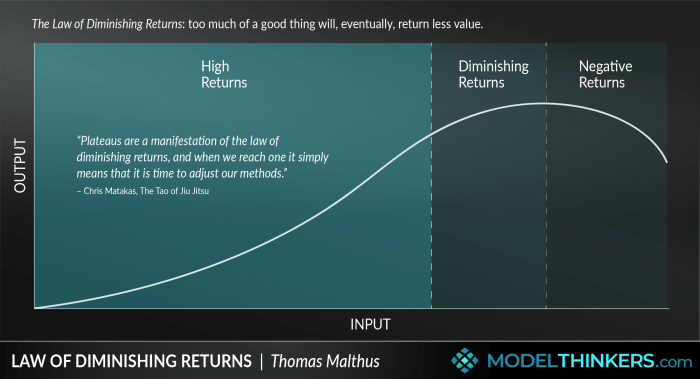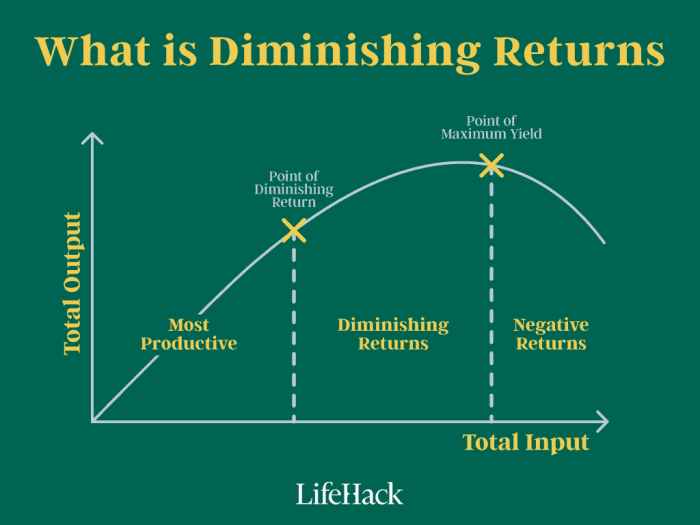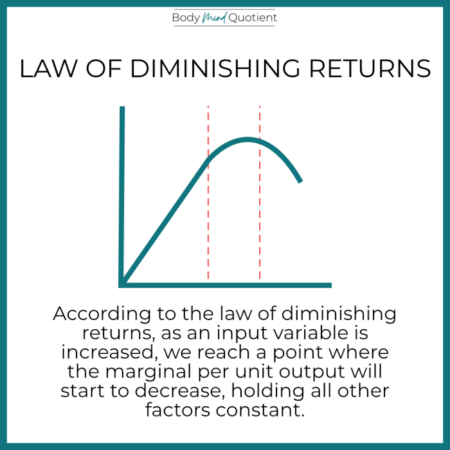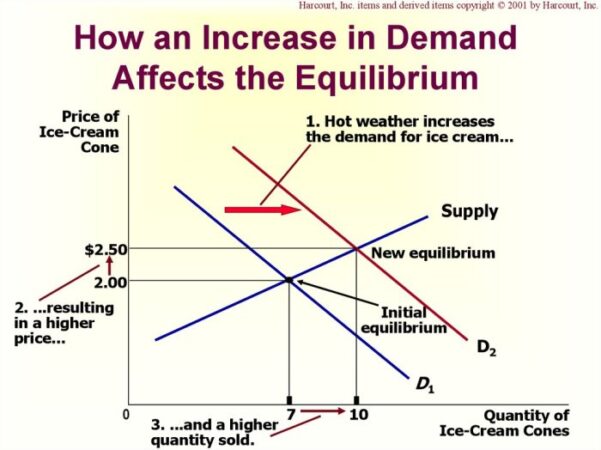
What is the law of diminishing returns sets the stage for this enthralling narrative, offering readers a glimpse into a story that is rich in detail and brimming with originality from the outset. This economic principle, often referred to as the law of diminishing marginal returns, describes a fundamental concept in production and consumption: as you increase the amount of one input while holding other inputs constant, the resulting increase in output will eventually become smaller and smaller.
Imagine baking cookies. Adding one extra egg to the first batch might dramatically increase the number of cookies you can bake. However, adding a fifth or sixth egg might only yield a few extra cookies, or even result in a less desirable outcome. This is because the additional eggs are no longer contributing as much to the overall production, demonstrating the law of diminishing returns. This principle applies to various industries, from agriculture to manufacturing to technology, and it plays a crucial role in understanding how businesses make decisions, how governments manage economies, and how individuals allocate their resources.
Introduction to the Law of Diminishing Returns

The law of diminishing returns is a fundamental economic principle that describes the relationship between inputs and outputs in production. It states that as you increase one input while holding other inputs constant, the resulting increase in output will eventually become smaller and smaller. In simpler terms, you get less and less extra output for each additional unit of input.
This concept has been recognized for centuries, with its roots tracing back to the 18th century. Early economists like Johann Heinrich von Thünen and David Ricardo observed that the returns to agricultural land declined as more labor and capital were applied to it. This led to the development of the concept of diminishing marginal returns, which later evolved into the broader law of diminishing returns.
The Core Principle of Diminishing Returns
The core principle of the law of diminishing returns is that as you increase one input while keeping other inputs constant, the marginal product of that input will eventually decrease. Marginal product refers to the additional output produced by using one more unit of the input.
The law of diminishing returns states that as you increase one input while holding other inputs constant, the resulting increase in output will eventually become smaller and smaller.
This principle can be illustrated with a simple example. Imagine a farmer who wants to increase the yield of his wheat crop. He can add more fertilizer to his fields, but the additional yield from each extra bag of fertilizer will eventually decrease. Initially, the extra fertilizer might significantly boost the yield, but as the soil becomes saturated with nutrients, the additional benefit from each extra bag of fertilizer will decline.
This is because other inputs, like sunlight, water, and land, are held constant. Eventually, the soil will be so saturated with nutrients that adding more fertilizer will have little to no impact on the yield. This demonstrates the diminishing returns to the input of fertilizer.
Examples of the Law of Diminishing Returns

The law of diminishing returns is a fundamental economic principle that applies to various aspects of life. It explains that as we increase the use of one input, while keeping other inputs constant, the output will eventually increase at a decreasing rate. Let’s explore some real-world examples to understand this concept better.
Everyday Life Examples
Everyday life is filled with instances of diminishing returns. Consider baking cookies. If you add one extra egg to your cookie recipe, you might get a slightly larger and tastier cookie. However, adding another egg might not result in a significant improvement in size or taste. In fact, adding too many eggs could make the cookies too dense and chewy. Similarly, studying for an exam can demonstrate the law of diminishing returns. Studying for a few hours might significantly improve your understanding of the material and your exam score. However, studying for 10 hours straight might not yield a proportional increase in your understanding or exam score. After a certain point, your brain may become fatigued, and your ability to absorb information may decline.
Industry Examples
The law of diminishing returns is also prevalent in various industries.
Manufacturing
In manufacturing, adding more workers to a production line can increase output initially. However, as the number of workers increases, the production line may become crowded, leading to inefficiencies and reduced productivity. This is because there is a limited amount of space, equipment, and resources available, and adding more workers beyond a certain point will not significantly increase output.
Agriculture
In agriculture, adding more fertilizer to a field can increase crop yield initially. But, after a certain point, adding more fertilizer will have a diminishing effect on yield. This is because the soil can only absorb a certain amount of nutrients, and excess fertilizer can even harm the crops.
Technology
In the technology sector, adding more features to a software product can initially attract more users. However, as the product becomes more complex, it can become difficult to use and understand, leading to user frustration and a decrease in adoption. This is because users have a limited capacity to learn and adapt to new features.
Examples in Table Format
The table below summarizes the examples discussed above:
| Industry | Input | Output | Diminishing Returns Effect |
|—|—|—|—|
| Baking | Eggs | Cookie size and taste | Adding more eggs beyond a certain point will not significantly improve the cookie’s size or taste. |
| Studying | Study hours | Exam score | Studying for longer hours beyond a certain point will not significantly improve your exam score. |
| Manufacturing | Workers | Production output | Adding more workers beyond a certain point will not significantly increase production output. |
| Agriculture | Fertilizer | Crop yield | Adding more fertilizer beyond a certain point will not significantly increase crop yield. |
| Technology | Software features | User adoption | Adding more features beyond a certain point will not significantly increase user adoption. |
Factors Affecting Diminishing Returns
The law of diminishing returns is not a rigid rule; its impact can be influenced by various factors. Understanding these factors helps businesses and individuals make informed decisions to optimize resource utilization and maximize output.
Role of Fixed and Variable Factors
The law of diminishing returns operates within the context of fixed and variable factors of production. Fixed factors, such as land and capital, are relatively constant in the short run. Variable factors, such as labor and materials, can be adjusted as needed. The interplay between these factors influences the rate at which diminishing returns set in.
- Fixed Factors: As more variable factors are added to a fixed factor, the marginal output from each additional unit of the variable factor eventually declines. For example, a farmer with a fixed amount of land may initially see increased output by adding more workers. However, as the number of workers increases, the land becomes more crowded, and each additional worker contributes less to overall output. This is because the fixed factor (land) becomes a constraint on the productivity of the variable factor (labor).
- Variable Factors: The availability and quality of variable factors also influence diminishing returns. If the quality of labor or materials decreases, the rate of diminishing returns can accelerate. For instance, if a company hires unskilled workers to operate sophisticated machinery, the output may decline more rapidly than if skilled workers were employed. Conversely, if a company invests in high-quality materials, it may experience a slower rate of diminishing returns.
Impact of Technology, What is the law of diminishing returns
Technological advancements can influence the law of diminishing returns in several ways.
- Increased Efficiency: Technology can increase the efficiency of production processes, potentially delaying the onset of diminishing returns. For example, the introduction of automation in manufacturing can allow a company to produce more goods with the same number of workers, thus extending the period before diminishing returns become significant.
- New Production Possibilities: Technological innovations can create new production possibilities, leading to entirely new products and services. These innovations can temporarily offset diminishing returns by expanding the production frontier and creating new markets. For example, the development of smartphones and the internet has created new industries and significantly altered consumer behavior, leading to a surge in economic activity and delaying the onset of diminishing returns in many sectors.
Other Factors
Besides fixed and variable factors and technology, other factors can influence the law of diminishing returns.
- Resource Quality: The quality of resources, including labor, capital, and raw materials, can impact the rate of diminishing returns. High-quality resources can lead to higher productivity and a slower rate of diminishing returns. Conversely, low-quality resources can result in lower productivity and faster diminishing returns.
- Management Practices: Effective management practices can help mitigate the impact of diminishing returns. By optimizing resource allocation, improving training, and fostering a positive work environment, managers can enhance productivity and extend the period before diminishing returns become significant.
- Market Conditions: Market conditions, such as demand, competition, and prices, can also influence diminishing returns. If demand for a product is high, a company may be able to increase production without experiencing significant diminishing returns. However, if demand is low or competition is intense, diminishing returns may set in more quickly.
Applications of the Law of Diminishing Returns: What Is The Law Of Diminishing Returns
The Law of Diminishing Returns is a fundamental economic principle that has significant applications in various fields, particularly in business and government decision-making. It helps businesses optimize resource allocation and governments understand economic growth and productivity.
Business Applications
The Law of Diminishing Returns is a valuable tool for businesses to make informed decisions about resource allocation. By understanding this principle, businesses can determine the optimal level of input to maximize output and minimize costs.
- Production Optimization: Businesses can use the Law of Diminishing Returns to determine the point where adding more input will yield diminishing returns. For instance, a manufacturing company might find that adding more workers to a production line initially increases output significantly, but eventually, the increase in output slows down as the line becomes crowded and less efficient. By understanding this point, businesses can avoid over-investing in resources and maximize their profits.
- Pricing Strategies: The Law of Diminishing Returns can also inform pricing strategies. For example, a restaurant might find that increasing the size of its portions initially attracts more customers, but eventually, the increase in sales plateaus as customers become less willing to pay for larger portions. Understanding this pattern helps businesses determine the optimal price point to maximize revenue.
- Marketing and Advertising: The Law of Diminishing Returns can also apply to marketing and advertising efforts. Initially, increasing advertising expenditure might lead to significant increases in sales. However, at some point, the impact of additional advertising may diminish as the market becomes saturated, and consumers become less receptive to the message. Businesses can use this understanding to allocate their marketing budgets effectively.
Government Applications
Governments can use the Law of Diminishing Returns to understand economic growth and productivity. This principle helps policymakers make informed decisions about public spending and resource allocation.
- Infrastructure Investment: Governments can use the Law of Diminishing Returns to evaluate the effectiveness of infrastructure investments. For instance, investing in a new highway might initially lead to significant economic growth, but as the road network becomes more congested, the benefits of additional investments may diminish. Governments can use this understanding to prioritize infrastructure projects and maximize their impact.
- Education and Training: The Law of Diminishing Returns can also apply to education and training investments. Increasing funding for education might initially lead to significant improvements in human capital and productivity. However, at some point, the returns on additional investment may diminish as the quality of education and training plateaus. Governments can use this understanding to allocate their education budgets effectively.
- Research and Development: Governments can also use the Law of Diminishing Returns to evaluate the effectiveness of research and development investments. Investing in new technologies might initially lead to significant economic growth and innovation. However, as the frontier of knowledge expands, the returns on additional investments may diminish. Governments can use this understanding to prioritize research and development projects and maximize their impact.
Comparison with Economies of Scale
The Law of Diminishing Returns is often contrasted with the concept of economies of scale. Economies of scale refer to the cost advantages that arise from increasing production. As a company produces more units, its average cost per unit decreases. This is because fixed costs, such as rent and equipment, are spread over a larger number of units.
- Differences: The Law of Diminishing Returns focuses on the relationship between input and output, while economies of scale focus on the relationship between production volume and average cost. Diminishing returns occur when adding more input leads to a decreasing marginal output, while economies of scale occur when increasing production volume leads to decreasing average costs.
- Similarities: Both concepts highlight the importance of optimizing resource allocation. While the Law of Diminishing Returns suggests that adding more input will eventually lead to diminishing returns, economies of scale suggest that increasing production volume will eventually lead to diminishing cost advantages.
- Combined Effects: In practice, both concepts can operate simultaneously. A company might experience economies of scale as it increases production, but also face diminishing returns as it reaches a certain production level. For example, a manufacturing company might benefit from lower average costs as it increases production, but also experience diminishing returns as its production facilities become congested and less efficient.
Implications of the Law of Diminishing Returns
The Law of Diminishing Returns, while a fundamental principle in economics, has significant implications for businesses, industries, and even entire economies. Understanding these implications is crucial for making informed decisions about resource allocation, innovation, and long-term growth.
Limitations of the Law in the Long Run
The Law of Diminishing Returns primarily applies to the short run, where at least one input factor is fixed. In the long run, all factors can be adjusted, potentially mitigating the effects of diminishing returns. However, it’s important to note that even in the long run, technological advancements and innovation might only delay, not completely eliminate, diminishing returns.
Overcoming Diminishing Returns with Innovation
Innovation plays a critical role in overcoming the limitations of the Law of Diminishing Returns. By introducing new technologies, processes, or products, businesses can increase productivity and output even with limited resources. For example, the development of high-yield crop varieties has significantly increased agricultural output, counteracting diminishing returns in land use.
Impact of Diminishing Returns Across Sectors
The Law of Diminishing Returns affects various sectors in different ways. The following table highlights the impact, potential solutions, and future implications in some key sectors:
| Sector | Impact of Diminishing Returns | Potential Solutions | Future Implications |
|---|---|---|---|
| Agriculture | Decreasing yields per acre with increased use of fertilizers and pesticides | Precision agriculture, sustainable farming practices, biotechnology | Increased reliance on technology for food production, potential for food security challenges |
| Manufacturing | Lower returns on investment in additional capital with existing technology | Automation, robotics, Industry 4.0 technologies | Increased efficiency and productivity, potential for job displacement |
| Energy | Decreasing returns from traditional fossil fuels | Renewable energy sources, energy efficiency measures | Transition to a sustainable energy future, potential for energy security challenges |
| Technology | Decreasing returns on investment in research and development | Breakthrough innovations, collaboration, open-source platforms | Continued technological advancements, potential for ethical considerations |
Final Thoughts

The law of diminishing returns is a powerful tool for understanding economic behavior and making informed decisions. It helps us recognize the limitations of increasing inputs, highlighting the importance of efficiency and optimization. While the law suggests that growth may eventually slow down, it doesn’t imply stagnation. Innovation, technological advancements, and strategic resource allocation can help overcome the limitations of diminishing returns, driving progress and creating new opportunities. By understanding this fundamental economic principle, we gain a deeper appreciation for the complexities of production, consumption, and economic growth.
Detailed FAQs
What are some real-world examples of diminishing returns?
Beyond baking cookies, consider a factory producing cars. Adding more workers to the assembly line initially increases production. However, as the number of workers grows, space constraints, equipment limitations, and potential communication issues can lead to diminishing returns. Each additional worker might contribute less to overall output, ultimately reaching a point where adding more workers actually decreases efficiency.
Does the law of diminishing returns always apply?
While the law of diminishing returns is a powerful concept, it’s not a universal rule. Technological advancements and innovation can sometimes shift the curve of diminishing returns, allowing for continued growth even with increased inputs. For example, the introduction of new machinery or software can increase productivity and offset the effects of diminishing returns.
How can businesses use the law of diminishing returns to their advantage?
Businesses can use the law of diminishing returns to make informed decisions about resource allocation. By analyzing the relationship between inputs and outputs, they can identify the optimal levels of investment in labor, capital, and other resources. This helps them maximize efficiency and profitability while minimizing waste and unnecessary expenditures.

